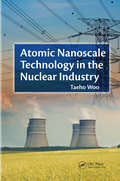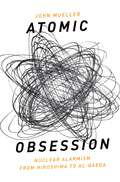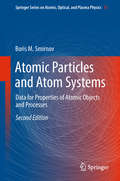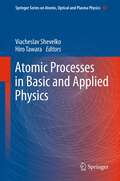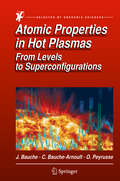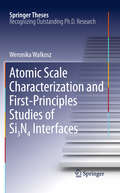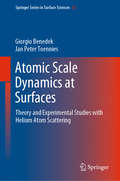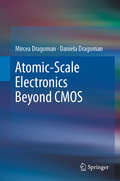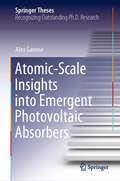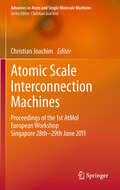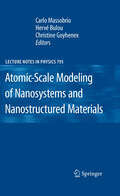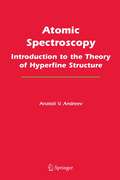- Table View
- List View
Atomic Inner-Shell Physics (Physics of Atoms and Molecules)
by Bernd CrasemannThe physics of atomic inner shells has undergone significant advances in recent years. Fast computers and new experimental tools, notably syn chrotron-radiation sources and heavy-ion accelerators, have greatly enhan ced the scope of problems that are accessible. The level of research activity is growing substantially; added incentives are provided by the importance of inner-shell processes in such diverse areas as plasma studies, astrophysics, laser technology, biology, medicine, and materials science. The main reason for all this exciting activity in atomic inner-shell physics, to be sure, lies in the significance of the fundamental problems that are coming within grasp. The large energies of many inner-shell processes cause relativistic and quantum-electrodynamic effects to become strong. Unique opportunities exist for delicate tests of such phenomena as the screening of the electron self-energy and the limits of validity of the present form of the frequency-dependent Breit interaction, to name but two. The many-body problem, which pervades virtually all of physics, presents somewhat less intractable aspects in the atomic inner-shell regime: correlations are relatively weak so that they can be treated perturbatively, and the basic potential is simple and known! The dynamics of inner-shell processes are characterized by exceedingly short lifetimes and high transition rates that strain perturbation theory to its limits and obliterate the traditional separation of excitation and deexcitation. These factors are only now being explored, as are interference phenomena between the various channels.
Atomic Layer Deposition: Principles, Characteristics, and Nanotechnology Applications
by Tommi Kääriäinen David Cameron Marja-Leena Kääriäinen Arthur ShermanSince the first edition was published in 2008, Atomic Layer Deposition (ALD) has emerged as a powerful, and sometimes preferred, deposition technology. The new edition of this groundbreaking monograph is the first text to review the subject of ALD comprehensively from a practical perspective. It covers ALD's application to microelectronics (MEMS) and nanotechnology; many important new and emerging applications; thermal processes for ALD growth of nanometer thick films of semiconductors, oxides, metals and nitrides; and the formation of organic and hybrid materials.
Atomic Layer Deposition: Principles, Characteristics, and Nanotechnology Applications
by Tommi Kääriäinen David Cameron Marja-Leena Kääriäinen Arthur ShermanSince the first edition was published in 2008, Atomic Layer Deposition (ALD) has emerged as a powerful, and sometimes preferred, deposition technology. The new edition of this groundbreaking monograph is the first text to review the subject of ALD comprehensively from a practical perspective. It covers ALD's application to microelectronics (MEMS) and nanotechnology; many important new and emerging applications; thermal processes for ALD growth of nanometer thick films of semiconductors, oxides, metals and nitrides; and the formation of organic and hybrid materials.
Atomic Layer Deposition for Semiconductors
by Cheol Seong HwangOffering thorough coverage of atomic layer deposition (ALD), this book moves from basic chemistry of ALD and modeling of processes to examine ALD in memory, logic devices and machines. Reviews history, operating principles and ALD processes for each device.
Atomic Layer Deposition in Energy Conversion Applications
by Julien BachmannCombining the two topics for the first time, this book begins with an introduction to the recent challenges in energy conversion devices from a materials preparation perspective and how they can be overcome by using atomic layer deposition (ALD). By bridging these subjects it helps ALD specialists to understand the requirements within the energy conversion field, and researchers in energy conversion to become acquainted with the opportunities offered by ALD. With its main focus on applications of ALD for photovoltaics, electrochemical energy storage, and photo- and electrochemical devices, this is important reading for materials scientists, surface chemists, electrochemists, electrotechnicians, physicists, and those working in the semiconductor industry.
Atomic Layer Deposition in Energy Conversion Applications
by Julien BachmannCombining the two topics for the first time, this book begins with an introduction to the recent challenges in energy conversion devices from a materials preparation perspective and how they can be overcome by using atomic layer deposition (ALD). By bridging these subjects it helps ALD specialists to understand the requirements within the energy conversion field, and researchers in energy conversion to become acquainted with the opportunities offered by ALD. With its main focus on applications of ALD for photovoltaics, electrochemical energy storage, and photo- and electrochemical devices, this is important reading for materials scientists, surface chemists, electrochemists, electrotechnicians, physicists, and those working in the semiconductor industry.
Atomic Layer Deposition of Nanostructured Materials
by Nicola Pinna Mato KnezAtomic layer deposition, formerly called atomic layer epitaxy, was developed in the 1970s to meet the needs of producing high-quality, large-area fl at displays with perfect structure and process controllability. Nowadays, creating nanomaterials and producing nanostructures with structural perfection is an important goal for many applications in nanotechnology. As ALD is one of the important techniques which offers good control over the surface structures created, it is more and more in the focus of scientists. The book is structured in such a way to fi t both the need of the expert reader (due to the systematic presentation of the results at the forefront of the technique and their applications) and the ones of students and newcomers to the fi eld (through the first part detailing the basic aspects of the technique). This book is a must-have for all Materials Scientists, Surface Chemists, Physicists, and Scientists in the Semiconductor Industry.
Atomic Layer Deposition of Nanostructured Materials
by Nicola Pinna Mato KnezAtomic layer deposition, formerly called atomic layer epitaxy, was developed in the 1970s to meet the needs of producing high-quality, large-area fl at displays with perfect structure and process controllability. Nowadays, creating nanomaterials and producing nanostructures with structural perfection is an important goal for many applications in nanotechnology. As ALD is one of the important techniques which offers good control over the surface structures created, it is more and more in the focus of scientists. The book is structured in such a way to fi t both the need of the expert reader (due to the systematic presentation of the results at the forefront of the technique and their applications) and the ones of students and newcomers to the fi eld (through the first part detailing the basic aspects of the technique). This book is a must-have for all Materials Scientists, Surface Chemists, Physicists, and Scientists in the Semiconductor Industry.
Atomic Layer Processing: Semiconductor Dry Etching Technology
by Thorsten LillLearn about fundamental and advanced topics in etching with this practical guide Atomic Layer Processing: Semiconductor Dry Etching Technology delivers a hands-on, one-stop resource for understanding etching technologies and their applications. The distinguished scientist, executive, and author offers readers in-depth information on the various etching technologies used in the semiconductor industry, including thermal, isotropic atomic layer, radical, ion-assisted, and reactive ion etching. The book begins with a brief history of etching technology and the role it has played in the information technology revolution, along with a collection of commonly used terminology in the industry. It then moves on to discuss a variety of different etching techniques, before concluding with discussions of the fundamentals of etching reactor design and newly emerging topics in the field such as the role played by artificial intelligence in the technology. Atomic Layer Processing includes a wide variety of other topics as well, all of which contribute to the author’s goal of providing the reader with an atomic-level understanding of dry etching technology sufficient to develop specific solutions for existing and emerging semiconductor technologies. Readers will benefit from: A complete discussion of the fundamentals of how to remove atoms from various surfaces An examination of emerging etching technologies, including laser and electron beam assisted etching A treatment of process control in etching technology and the role played by artificial intelligence Analyses of a wide variety of etching methods, including thermal or vapor etching, isotropic atomic layer etching, radical etching, directional atomic layer etching, and more Perfect for materials scientists, semiconductor physicists, and surface chemists, Atomic Layer Processing will also earn a place in the libraries of engineering scientists in industry and academia, as well as anyone involved with the manufacture of semiconductor technology. The author’s close involvement with corporate research & development and academic research allows the book to offer a uniquely multifaceted approach to the subject.
Atomic Layer Processing: Semiconductor Dry Etching Technology
by Thorsten LillLearn about fundamental and advanced topics in etching with this practical guide Atomic Layer Processing: Semiconductor Dry Etching Technology delivers a hands-on, one-stop resource for understanding etching technologies and their applications. The distinguished scientist, executive, and author offers readers in-depth information on the various etching technologies used in the semiconductor industry, including thermal, isotropic atomic layer, radical, ion-assisted, and reactive ion etching. The book begins with a brief history of etching technology and the role it has played in the information technology revolution, along with a collection of commonly used terminology in the industry. It then moves on to discuss a variety of different etching techniques, before concluding with discussions of the fundamentals of etching reactor design and newly emerging topics in the field such as the role played by artificial intelligence in the technology. Atomic Layer Processing includes a wide variety of other topics as well, all of which contribute to the author’s goal of providing the reader with an atomic-level understanding of dry etching technology sufficient to develop specific solutions for existing and emerging semiconductor technologies. Readers will benefit from: A complete discussion of the fundamentals of how to remove atoms from various surfaces An examination of emerging etching technologies, including laser and electron beam assisted etching A treatment of process control in etching technology and the role played by artificial intelligence Analyses of a wide variety of etching methods, including thermal or vapor etching, isotropic atomic layer etching, radical etching, directional atomic layer etching, and more Perfect for materials scientists, semiconductor physicists, and surface chemists, Atomic Layer Processing will also earn a place in the libraries of engineering scientists in industry and academia, as well as anyone involved with the manufacture of semiconductor technology. The author’s close involvement with corporate research & development and academic research allows the book to offer a uniquely multifaceted approach to the subject.
Atomic Nanoscale Technology in the Nuclear Industry (Devices, Circuits, and Systems)
by Taeho WooDevelopments at the nanoscale are leading to new possibilities and challenges for nuclear applications in areas ranging from medicine to international commerce to atomic power production/waste treatment. Progress in nanotech is helping the nuclear industry slash the cost of energy production. It also continues to improve application reliability and safety measures, which remain a critical concern, especially since the reactor disasters in Japan. Exploring the new wide-ranging landscape of nuclear function, Atomic Nanoscale Technology in the Nuclear Industry details the breakthroughs in nanoscale applications and methodologies that are revolutionizing power production, biotechnology, and material science. Developments in atomic nanoscale technology have given us the ability to: Use ion beams to Investigate and optimize radiation energy losses at the nanoscopic level Assess nanoscopic safety circumstances involved in a reactor failure Analyze characteristics of nuclear spacecraft operating in the nanogravity of deep space Evaluate light collection enhancement for digital X-ray detection Apply brachytherapy using radioisotopes for cancer therapy Treat nuclear waste at the nanoscopic level Use systems-thinking decision making to analyze financial progress of nanotech in the energy industry Assess safety (and safety management methods) for nuclear nanomaterials used in plant operations Representing a first step in multi-combinatorial research, this text incorporates advanced studies that use Monte Carlo and solid-state measurement (including radiation detection) methods. Researchers used these to demonstrate the potential to upgrade methods of radiation protection and nuclear reactor operation (safety, waste disposal, etc.). The author also addresses how we can use nanotechnology to address industrial concerns and enhance nuclear medicine techniques. He highlights several nanomaterial systems and devices to illustrate developments in this area. About the Author: Taeho Woo launched the specialized field of atomic multinology (interdisciplinary research of nuclear technology), which combines the application of information technology, biotechnology, and nanotechnology in the nuclear industry.
Atomic Nanoscale Technology in the Nuclear Industry (Devices, Circuits, and Systems)
by Taeho WooDevelopments at the nanoscale are leading to new possibilities and challenges for nuclear applications in areas ranging from medicine to international commerce to atomic power production/waste treatment. Progress in nanotech is helping the nuclear industry slash the cost of energy production. It also continues to improve application reliability and safety measures, which remain a critical concern, especially since the reactor disasters in Japan. Exploring the new wide-ranging landscape of nuclear function, Atomic Nanoscale Technology in the Nuclear Industry details the breakthroughs in nanoscale applications and methodologies that are revolutionizing power production, biotechnology, and material science. Developments in atomic nanoscale technology have given us the ability to: Use ion beams to Investigate and optimize radiation energy losses at the nanoscopic level Assess nanoscopic safety circumstances involved in a reactor failure Analyze characteristics of nuclear spacecraft operating in the nanogravity of deep space Evaluate light collection enhancement for digital X-ray detection Apply brachytherapy using radioisotopes for cancer therapy Treat nuclear waste at the nanoscopic level Use systems-thinking decision making to analyze financial progress of nanotech in the energy industry Assess safety (and safety management methods) for nuclear nanomaterials used in plant operations Representing a first step in multi-combinatorial research, this text incorporates advanced studies that use Monte Carlo and solid-state measurement (including radiation detection) methods. Researchers used these to demonstrate the potential to upgrade methods of radiation protection and nuclear reactor operation (safety, waste disposal, etc.). The author also addresses how we can use nanotechnology to address industrial concerns and enhance nuclear medicine techniques. He highlights several nanomaterial systems and devices to illustrate developments in this area. About the Author: Taeho Woo launched the specialized field of atomic multinology (interdisciplinary research of nuclear technology), which combines the application of information technology, biotechnology, and nanotechnology in the nuclear industry.
Atomic Obsession: Nuclear Alarmism from Hiroshima to Al-Qaeda
by John MuellerFollowing 9/11, Americans were swept up in a near hysteria-level fear of terrorists, especially of Islamic extremists working domestically. The government and media reports stoked fears that people living in the US have the desire and means to wreak extreme havoc and destruction. Early reports estimated slightly more than 300 al Qaeda operatives living in the United States. It wasn't long before this number became 2,000 or 5,000 domestic terrorists. As these estimates snowballed, so did spending on federal counterterrorism organizations and measures, spending which now totals over a trillion dollars. The federal government launched more covert operations in the name of fighting terrorist adversaries than they did in the entirety of the forty-five year Cold War. For each apprehension of a credible terrorist suspect, the US government created or re-organized two counterterrorism organizations. The scale of these efforts has been enormous, yet somehow they have not been proven to make Americans feels safe from what they perceive to be a massive terrorist threat. But how well-founded is this fear? Is the threat of terrorism in the United States as vast as it seems and are counterterrorism efforts effective and appropriately-scaled? It has not, statistically speaking, been efficient or successful. Only one alarm in 10,000 has proven to be a legitimate threat-the rest are what the authors refer to as "ghosts." These ghosts are enormous drains on resources and contribute to a countrywide paranoia that has resulted in widespread support and minimal critical questioning of massive expenditures and infringements on civil liberties, including invasions of privacy and questionably legal imprisonments. In Chasing Ghosts, John Mueller and Mark Stewart argue that the "ghost chase" occupying American fears, law enforcement, and federal spending persists because the public believes that there exists in the US a dire and significant threat of terrorism. The authors seek to analyze to what degree this is a true and to what degree the threat posed by terrorists in the US defends the extraordinary costs currently put towards their investigation. The chance that an American will be killed by a terrorist domestically in any given year is about one in four million (under present conditions). Yet despite this statistically low risk and the extraordinary amount of resources put towards combatting threats, Americans do not profess to feel any safer from terrorists. Until the true threat of domestic terrorism is analyzed and understood, the country cannot begin to confront whether our pursuit of ghosts is worth the cost.
Atomic Obsession: Nuclear Alarmism from Hiroshima to Al-Qaeda
by John MuellerFollowing 9/11, Americans were swept up in a near hysteria-level fear of terrorists, especially of Islamic extremists working domestically. The government and media reports stoked fears that people living in the US have the desire and means to wreak extreme havoc and destruction. Early reports estimated slightly more than 300 al Qaeda operatives living in the United States. It wasn't long before this number became 2,000 or 5,000 domestic terrorists. As these estimates snowballed, so did spending on federal counterterrorism organizations and measures, spending which now totals over a trillion dollars. The federal government launched more covert operations in the name of fighting terrorist adversaries than they did in the entirety of the forty-five year Cold War. For each apprehension of a credible terrorist suspect, the US government created or re-organized two counterterrorism organizations. The scale of these efforts has been enormous, yet somehow they have not been proven to make Americans feels safe from what they perceive to be a massive terrorist threat. But how well-founded is this fear? Is the threat of terrorism in the United States as vast as it seems and are counterterrorism efforts effective and appropriately-scaled? It has not, statistically speaking, been efficient or successful. Only one alarm in 10,000 has proven to be a legitimate threat-the rest are what the authors refer to as "ghosts." These ghosts are enormous drains on resources and contribute to a countrywide paranoia that has resulted in widespread support and minimal critical questioning of massive expenditures and infringements on civil liberties, including invasions of privacy and questionably legal imprisonments. In Chasing Ghosts, John Mueller and Mark Stewart argue that the "ghost chase" occupying American fears, law enforcement, and federal spending persists because the public believes that there exists in the US a dire and significant threat of terrorism. The authors seek to analyze to what degree this is a true and to what degree the threat posed by terrorists in the US defends the extraordinary costs currently put towards their investigation. The chance that an American will be killed by a terrorist domestically in any given year is about one in four million (under present conditions). Yet despite this statistically low risk and the extraordinary amount of resources put towards combatting threats, Americans do not profess to feel any safer from terrorists. Until the true threat of domestic terrorism is analyzed and understood, the country cannot begin to confront whether our pursuit of ghosts is worth the cost.
Atomic Particles and Atom Systems: Data for Properties of Atomic Objects and Processes (Springer Series on Atomic, Optical, and Plasma Physics #51)
by Boris M. SmirnovThis book presents physical units and widely used physical formulas, which are given together with conversion factors in various units. It includes frequently used atomic spectra and data for atoms, ions and molecules, as well as potential curves for diatomic molecules, and provides numerical parameters for transport phenomena in gases and plasmas. Further, the rate constants of a number of processes in atmospheric ionized air have been added to this second edition of the book. The numerical data has been selected from the information on atoms, atomic systems, atomic processes and models for atomic physics in this area, and the numerical parameters of atoms, ions and atom systems are included in periodical tables of elements.
Atomic Processes in Basic and Applied Physics (Springer Series on Atomic, Optical, and Plasma Physics #68)
by Viacheslav Shevelko and Hiro TawaraThe book is a comprehensive edition which considers the interactions of atoms, ions and molecules with charged particles, photons and laser fields and reflects the present understanding of atomic processes such as electron capture, target and projectile ionisation, photoabsorption and others occurring in most of laboratory and astrophysical plasma sources including many-photon and many-electron processes. The material consists of selected papers written by leading scientists in various fields.
Atomic Processes in Electron-Ion and Ion-Ion Collisions (Nato Science Series B: #145)
by F. BrouillardFour years after a first meeting in BADDECK, Canada, on the Physics of Ion-Ion and Electron-Ion collisions, a second Nato Advanced Study Institute, in HAl~/Lesse, Belgium, reexamined the subject which had become almost a new one, in consideration of the many important developments that had occured in the mean time. The developments have been particularly impressive in two areas : the di-electronic recombination of electrons with ions and the collisional processes of mUltiply charged ions. For dielectronic recombination, a major event was the obtainment, in 1983, of the first experimental data. This provided, at last, a non speculative basis for the study of that intricate and subtle process and strongly stimulated the theoretical activities. Multiply charged ions, on the other hand, have become popular, thanks to the development of powerful ion sources. This circumstance, together with a pressing demand from thermonuclear research for ionisation and charge exchange cross sections, has triggered systematic experimental investigations and new theoretical studies, which have contributed to considerably enlarge, over the last five years, our understanding of the collisional processes of multiply charged ions. Dielectronic recombination and multiply charged ions were therefore central points in the programme of the A.S.I. in HAN/Lesse and are given a corresponding emphasis in the present book.
Atomic Properties in Hot Plasmas: From Levels to Superconfigurations
by Jacques Bauche Claire Bauche-Arnoult Olivier PeyrusseThis book is devoted to the calculation of hot-plasma properties which generally requires a huge number of atomic data. It is the first book that combines information on the details of the basic atomic physics and its application to atomic spectroscopy with the use of the relevant statistical approaches. Information like energy levels, radiative rates, collisional and radiative cross-sections, etc., must be included in equilibrium or non-equilibrium models in order to describe both the atomic-population kinetics and the radiative properties. From the very large number of levels and transitions involved in complex ions, some statistical (global) properties emerge. The book presents a coherent set of concepts and compact formulas suitable for tractable and accurate calculations. The topics addressed are: radiative emission and absorption, and a dozen of other collisional and radiative processes; transition arrays between level ensembles (configurations, superconfigurations); effective temperatures of configurations, superconfigurations, and ions; charge-state distributions; radiative power losses and opacity. There are many numerical examples and comparisons with experiment presented throughout the book. The plasma properties described in this book are especially relevant to large nuclear fusion facilities such as the NIF (California) and the ITER (France), and to astrophysics.Methods relevant to the central-field configurational model are described in detail in the appendices: tensor-operator techniques, second-quantization formalism, statistical distribution moments, and the algebra of partition functions. Some extra tools are propensity laws, correlations, and fractals. These methods are applied to the analytical derivation of many properties, specially the global ones, through which the complexity is much reduced. The book is intended for graduate-level students, and for physicists working in the field.
Atomic Scale Characterization and First-Principles Studies of Si₃N₄ Interfaces (Springer Theses)
by Weronika WalkoszThis thesis presents results from a combined atomic-resolution Z-contrast and annular bright-field imaging and electron energy loss spectroscopy in the Scanning Transmission Electron Microscopy, as well as first principles studies of the interfaces between crystalline β−Si3N4 and amorphous (i) CeO2-x as well as (ii) SiO2 intergranular film (IGF). These interfaces are of a great fundamental and technological interest because they play an important role in the microstructural evolution and mechanical properties of Si3N4 ceramics used in many high temperature and pressure applications. The main contribution of this work is its detailed description of the bonding characteristics of light atoms, in particular oxygen and nitrogen, at these interfaces, which has not been achieved before. The atomic-scale information on the arrangement of both light and heavy atoms is critical for realistic modeling of interface properties, such as interface strength and ion transport, and will facilitate increased control over the performance of ceramic and semiconductor materials for a wide-range of applications.
Atomic Scale Dynamics at Surfaces: Theory and Experimental Studies with Helium Atom Scattering (Springer Series in Surface Sciences #63)
by Giorgio Benedek Jan Peter ToenniesExperimental advances in helium atom scattering spectroscopy over the last forty years have allowed the measurement of surface phonon dispersion curves of more than 200 different crystal surfaces and overlayers of insulators, semiconductors and metals. The first part of the book presents, at a tutorial level, the fundamental concepts and methods in surface lattice dynamics, and the theory of atom-surface interaction and inelastic scattering in their various approximations, up to the recent electron-phonon theory of helium atom scattering from conducting surfaces. The second part of the book, after introducing the experimentalist to He-atom spectrometers and the rich phenomenology of helium atom scattering from corrugated surfaces, illustrates the most significant experimental results on the surface phonon dispersion curves of various classes of insulators, semiconductors, metals, layered crystals, topological insulators, complex surfaces, adsorbates, ultra-thin films and clusters. The great potential of helium atom scattering for the study of atomic scale diffusion, THz surface collective excitations, including acoustic surface plasmons, and the future prospects of helium atom scattering are presented in the concluding chapters. The book will be valuable reading for all researchers and graduate students interested in dynamical processes at surfaces.
Atomic-Scale Electronics Beyond CMOS
by Mircea Dragoman Daniela DragomanThis book explores emerging topics in atomic- and nano-scale electronics after the era of Moore’s Law, covering both the physical principles behind, and technological implementations for many devices that are now expected to become key elements of the future of nanoelectronics beyond traditional complementary metal-oxide semiconductors (CMOS). Moore’s law is not a physical law itself, but rather a visionary prediction that has worked well for more than 50 years but is rapidly coming to its end as the gate length of CMOS transistors approaches the length-scale of only a few atoms. Thus, the key question here is: “What is the future for nanoelectronics beyond CMOS?” The possible answers are found in this book. Introducing novel quantum devices such as atomic–scale electronic devices, ballistic devices, memristors, superconducting devices, this book also presents the reader with the physical principles underlying new ways of computing, as well as their practical implementation. Topics such as quantum computing, neuromorphic computing are highlighted here as some of the most promising candidates for ushering in a new era of atomic-scale electronics beyond CMOS.
Atomic-Scale Insights into Emergent Photovoltaic Absorbers (Springer Theses)
by Alex GanoseThis book presents an original investigation into alternative photovoltaic absorbers. Solar power is a highly promising renewable energy solution; however, its success is hampered by the limited cost-effectiveness of current devices. The book assesses the photovoltaic performance of over 20 materials using state-of-the-art, first-principles methods. Adopting a computational approach, it investigates atomic-scale properties at a level of accuracy that is difficult to achieve using laboratory-based experimental techniques. Unlike many theoretical studies, it provides specific advice to those involved in experimental investigations. Further, it proposes directions for future research. This book advances the field of photovoltaics in three crucial ways: firstly, it identifies why one class of proposed materials cannot achieve high efficiency, while at the same time gaining insights that can be used to design future absorbers. Secondly, it shows that poor performance in the bismuth chalcohalides is not due to fundamental limitations, and can be overcome by finely controlling synthesis conditions. Lastly, it describes a range of new stable materials that are expected to show excellent photovoltaic performance.
Atomic Scale Interconnection Machines: Proceedings of the 1st AtMol European Workshop Singapore 28th-29th June 2011 (Advances in Atom and Single Molecule Machines)
by Christian JoachimThis volume documents the first International Workshop on Atomic Scale Interconnection Machines organised by the European Integrated Project AtMol in June 2011 in Singapore. The four sessions, discussed here in revised contributions by high level speakers, span the subjects of multi-probe UHV instrumentation, atomic scale nano-material nanowires characterization, atomic scale surface conductance measurements, surface atomic scale mechanical machineries. This state-of-the-art account brings academic researchers and industry engineers access to the tools they need to be at the forefront of the atomic scale technology revolution.
Atomic-Scale Modeling of Nanosystems and Nanostructured Materials (Lecture Notes in Physics #795)
by Carlo Massobrio Hervé Bulou Christine GoyhenexUnderstanding the structural organization of materials at the atomic scale is a lo- standing challenge of condensed matter physics and chemistry. By reducing the size of synthesized systems down to the nanometer, or by constructing them as collection of nanoscale size constitutive units, researchers are faced with the task of going beyond models and interpretations based on bulk behavior. Among the wealth of new materials having in common a “nanoscale” ngerprint, one can encounter systems intrinsically extending to a few nanometers (clusters of various compo- tions), systems featuring at least one spatial dimension not repeated periodically in space and assemblies of nanoscale grains forming extended compounds. For all these cases, there is a compelling need of an atomic-scale information combining knowledge of the topology of the system and of its bonding behavior, based on the electronic structure and its interplay with the atomic con gurations. Recent dev- opments in computer architectures and progresses in available computational power have made possible the practical realization of a paradygma that appeared totally unrealistic at the outset of computer simulations in materials science. This consists inbeing able to parallel (at least inprinciple) any experimental effort by asimulation counterpart, this occurring at the scale most appropriate to complement and enrich the experiment.
Atomic Spectroscopy: Introduction to the Theory of Hyperfine Structure
by Anatoli V. AndreevAtomic Spectroscopy provides a comprehensive discussion on the general approach to the theory of atomic spectra, based on the use of the Lagrangian canonical formalism. This approach is developed and applied to explain the hydrogenic hyperfine structure associated with the nucleus motion, its finite mass, and spin. The non-relativistic or relativistic, spin or spin-free particle approximations can be used as a starting point of general approach. The special attention is paid to the theory of Lamb shift formation. The formulae for hydrogenic spectrum including the account of Lamb shift are written in simple analytical form. The book is of interest to specialists, graduate and postgraduate students, who are involved into the experimental and theoretical research in the field of modern atomic spectroscopy.







